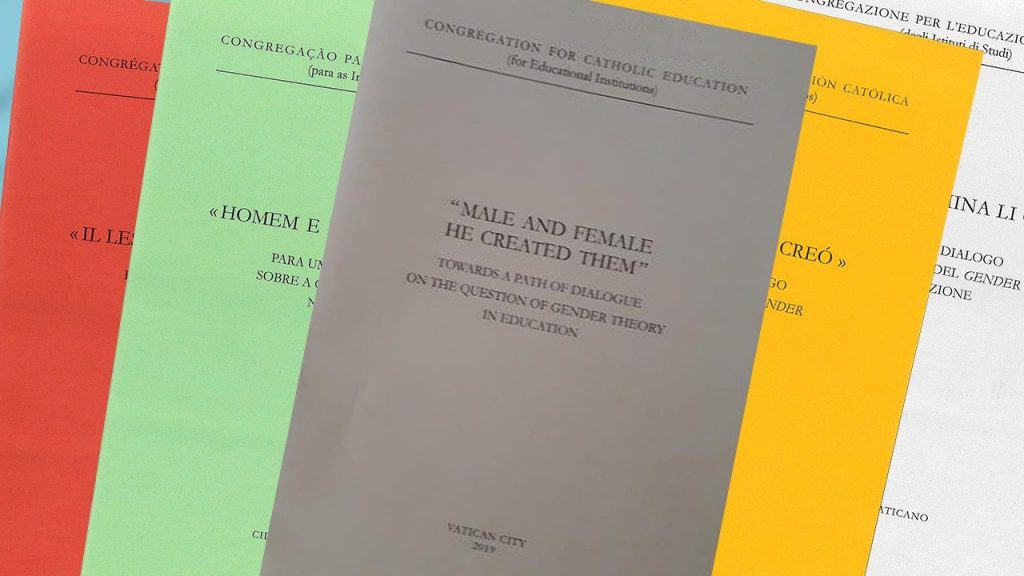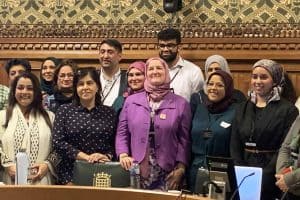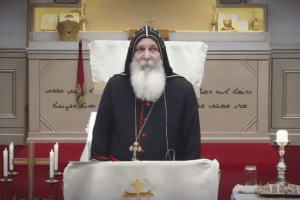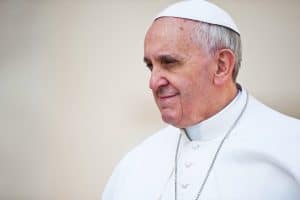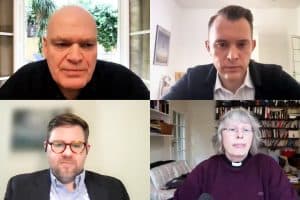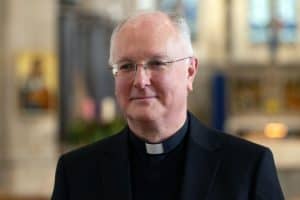by Catherine Pepinster
The Vatican’s decision to issue guidance on transgender issues has caused alarm and criticism among LGBT groups after the document was highly critical of contemporary thinking on gender and identity.
The 31-page document, Male and Female He Created Them. Towards a Path of Dialogue on the Question of Gender in Education, was released by the Congregation for Catholic Education on 10 June 2019 and focuses on issues such as transgenderism, polyamory (relationships with more than one partner) and third sex (people who consider themselves neither man nor women).
Controversial papers about Catholic beliefs and doctrine are usually published by the Congregation for the Doctrine of the Faith, but publication by this Vatican department is a sign of concern that this issue particularly affects children and what they are taught in schools. Its authors, Cardinal Giuseppe Versaldi and Archbishop Angelo Zani, describe it as an aid for Catholic school teachers and parents.
Indeed, the paper goes as far as to say that gender theory – which they define as claiming gender is a social construct which human beings, whatever their biological sex, can deconstruct – is causing an “educational crisis”. It also indicates where it stands on the issue by saying that accepting transgender could threaten the family and “annihilate the concept of nature”.
It is also noticeable that in the past few years that Pope Francis has made several critical comments about gender theory and has specifically commented on schools pushing the theory, talking about them colonising schools with the idea that gender was fluid. He also said in 2016 on a trip to Georgia, a country of the Caucasus, that gender theory was “the enemy of marriage”.
This document begins with a quote from Pope Francis’s own 2016 paper on love, Amoris Laetitia (The Joy of Love), much praised for its compassion and concern for humanity, but containing a critical definition of gender theory as something that “denies the difference and reciprocity in nature of a man and a woman and envisages a society without sexual differences, thereby eliminating the anthropological basis of the family.
“This ideology leads to educational programmes and legislative enactments that promote a personal identity and emotional intimacy radically separated from the biological difference between male and female. Consequently, human identity becomes the choice of the individual, one which can also change over time”.
In this latest document, the Vatican is both critical of the changing views of society about gender and is also confirming traditional thinking and using Scripture to support its position. Gender, the document says, is not something that can be changed but comes from God: “The Holy Scripture reveals the wisdom of the Creator’s design, which has assigned as a task to man his body, his masculinity and femininity.”
It also says that the biological differences between men and women are “constitutive of human identity”, and is critical of efforts to go beyond the clear either/or of male and female. It is noticeable that the Vatican has called its paper Male and Female He Created Them, while its arguments focus on “male OR female” and does not seem to spot the difference between the two. The document suggests that the Church rejects ideology and wants dialogue, but there is little sign that it is going to engage in debate and shift position.
“Efforts to go beyond the constitutive male-female sexual difference, such as the ideas of ‘intersex’ or ‘transgender,’ lead to a masculinity or femininity that is ambiguous,” the document states.
“This oscillation between male and female becomes, at the end of the day, only a ‘provocative’ display against so-called ‘traditional frameworks’.”
The Roman Catholic Church has always been emphatic that the family is the bedrock of society and of civilisation and that the family is made up of a man and a woman. Pope Benedict XVI said in 2006: “It is only the rock of total irrevocable love between a man and a woman that can serve as the foundation on which to build a society that will become a home for all mankind.”
Here the Congregation for Catholic Education warns that more ambiguous attitudes towards sexuality and gender has destabilised the family unit “bringing with it a tendency to cancel out the differences between men and women, presenting them instead as merely the product of historical and cultural conditioning”.
There is evident concern here that contemporary society is making a distinction between sex and gender whereas the Church sees the two as inextricably linked, just as the Church sees sex and procreation as inextricably linked, even if its recognises that a loving marital relationship might involve family planning (although natural, not artificial, birth control). Sex, gender, procreation, and heterosexual love: these are all interconnected and in that sense this document is part of a chain of teaching that takes us back to the controversies of Paul VI’s 1968 document on contraception, Humanae Vitae.
Although Catholics are not biblical literalists, this latest document uses Genesis to explain that God created man and woman and calls for the reaffirming of “the metaphysical roots of sexual difference”.
This gender-specific approach is also evident in the Church’s attitude to priesthood. It insists that a priest is in persona Christi – in the person of Christ – and mirrors him in his gender. Priests are also male because the apostles are male. The Church’s Catechism says: “In God’s sight, man and woman have the same dignity but they have different duties and charisms. The Church sees herself as bound by the fact that Jesus chose men exclusively to be present at the Last Supper for the institution of the priesthood.”
Contemporary challenges to the clear-cut difference between male and female is critiqued in the document, whose authors see these as a move away from nature.
“In this understanding of things, the view of both sexuality identity and the family become subject to the same ‘liquidity’ and ‘fluidity’ that characterise other aspects of post-modern culture, often founded on nothing more than a confused concept of freedom in the realm of feelings and wants, or momentary desires provoked by emotional impulses and the will of the individual,” it continues.
The document stresses the differences between men and women, using a favoured word of the past three popes, complementarity, which they use frequently to distinguish their belief that women while having equal dignity and worth cannot be the same as men – most notably stressed in their insistence on a male-only priesthood.
It says that gender ideology aims to remove the idea of complementarity between men and women, particularly when it comes to procreation, by proposing alternatives such as in vitro fertilisation and surrogacy, when a man and a woman are still needed for either process to work.
Gender theory ideology, the document warns, create educational programmes that try to negate the sexual differences between men and women, and confuse freedom with the idea that people can act “arbitrarily as if there were no truths, values and principles to provide guidance, and everything were possible and permissible”.
The importance of the difference between male and female and of complementarity in Francis’s thinking was evident in 2014 when he addressed participants in the International Colloquium on the Complementarity between Men and Women, sponsored by the Congregation for the Doctrine of the Faith.
Although the document does not carry the signature of Pope Francis, he is evidently highly critical of gender theory and in an interview in 2015 compared it to nuclear weapons, saying that the idea did not recognise the order of Creation.
The interview, conducted by journalist Andrea Tornielli, now heading the communications department at the Vatican, was included in a book, This Economy Kills: Pope Francis on Capitalism and Social Justice, which mostly focused on his thinking about social justice, the planet, sustainability and creation. But he also said: “With this attitude, man commits a new sin, that against God the Creator. The true custody of creation does not have anything to do with the ideologies that consider man like an accident, like a problem to eliminate.”
“God has placed man and woman and the summit of creation and has entrusted them with the earth,” Francis says. “The design of the Creator is written in nature.”
In January 2015 he also commented on gender theory during an interview on the papal plane when he recounted that an education minister in a developing world nation had said that he could receive First World money for schools if they used a textbook about gender theory.
The Pope called this “ideological colonisation”. He used the phrase again during a press conference nine months later on a trip to Azerbaijan. F had spoken there too about the involvement of schools in promoting gender theory, recalling a conversation with a French father whose 10-year-old son had told him he wanted to be a girl when he grew up.
“In their schoolbooks gender theory was being taught,” the Pope said. “This is against natural things. It is one thing for a person who has this tendency . . . and also changes their sex. It is another thing to teach in schools along this line. Changing the mentality: I call this ideological colonisation.”
But on the plane home he also expressed a more compassionated outlook, stressing the need to deal with situations on a case-by-case basis and spoke of meeting a transgender man from Spain at the Vatican in 2015. He said the man wrote to him describing what had happened and asked for a one-to-one meeting.
“She is a young woman who suffered much because she felt like a young man,” the Pope explained. “She felt like a young man, but she was physically a young woman.”
The woman then had gender reassignment surgery and married a woman. “He wrote me a letter saying that, for him, it would be a consolation to come [to see me] with his wife,” the Pope said, clarifying: “He that was her but is he.”
The transgender man spoke of his experience in his parish in Spain, where a younger priest had recently replaced his former parish priest, who had turned 80.
“When the new pastor would see him, he would shout to him from the sidewalk, ‘You will go to Hell’,” the Pope said. “But when the old pastor would come find him, he asked, ‘How long has it been since you confessed? Come and confess so you can have communion’.”
“Do you understand?” the Pope asked the journalists aboard the flight. “Life is life and you must take things as they come.
“We must be attentive, not saying all are the same,” he continued. “Every case: Welcome it, accompany it, study it, discerning and integrating. This is what Jesus would do today,” the Pope said.
It was an attitude that was similar to Francis’s “Who am I to judge?” comment when asked early in his pontificate about homosexuality.
The Catholic Church frequently distinguishes in matters of sexuality between actions and the person acting, saying that the action is wrong but the individual concerned must not be discriminated against. This is evident in its approach to gay people and is apparent in this document too.
There is also some part of this document that details some “points of agreement” with gender theory. The text praises educational programs that “share a laudable desire to combat all expressions of unjust discrimination, a requirement that can be shared by all sides”.
“Indeed, it cannot be denied that through the centuries forms of unjust discrimination have been a sad fact of history and have also had an influence within the Church,” it states.
“This has brought a certain rigid status quo, delaying the necessary and progressive inculturation of the truth of Jesus’s proclamation of the equal dignity of men and women, and has provoked accusations of a sort of masculinist mentality, veiled to a greater or lesser degree by religious motives,” it continues.
The document also acknowledges that there can be points in common, such as that children should be taught to appreciate the equal dignity of men and women; to respect every person in their particularity and difference, so that no one should suffer bullying, violence, insults or unjust discrimination based on their specific characteristics (such as special needs, race, religion, sexual tendencies); and to appreciate the values of femininity.
The document acknowledges that in some cases, sex is not clearly defined. But it is up to medical professionals to make a therapeutic intervention, and it is not up to parents, or society, to make an arbitrary decision.
However, for all these qualifications, the response to this document has been highly critical from people concerned about transgender, just as many gay people believe that the Church, in its teaching about homosexuality, is discriminatory in its action, despite its desire to see gay people treated with dignity and sensitivity.
The New Ways Ministry, a US advocacy group for LGBT Catholics, has described the document as a harmful tool that will be used to “oppress and harm not only transgender people, but lesbian, gay, bisexual people, too”.
Francis DeBernardo, executive director of the group, rejected the notion that people “choose their gender”. In a statement, he said the document will “confuse those who sincerely struggle with questions of gender identity and sexual orientation” and described the Vatican as being in the “dark ages” on this issue.
James Martin, a Jesuit priest who is one of the most respected and influential writers on gay issues in the Roman Catholic Church, was careful to find positive aspects to the document, pointing out in America magazine that:
“It is an explicit call for dialogue, which all should welcome. It speaks of a ‘path’, which indicates that the church has not yet reached the destination. It focuses on the ‘question’ of gender theory in education, which leaves some degree of openness, and is thus addressed mainly to educators and ‘formators’, including those responsible for the training of priests and members of religious orders.”
However, Martin went on to say that its traditional view of sexuality – that men and women have fixed sexual and gender roles – is . . .
“contradicted by what most biologists and psychologists now understand about both sexuality and gender. These contemporary advances in understanding human sexuality and gender have been set aside by the congregation in favour of a binary understanding of sexuality. Even the term ‘sexual orientation’ is put into quotes in the document, as if to call that very notion into question.”
Martin also points out that the Congregation, despite advocating dialogue, failed to have dialogue with LGBT people before producing the document:
“The document’s primary partners for conversation seem to be philosophers, theologians and older church documents and papal statements – not biologists or scientists, not psychiatrists or psychologists, and not LGBT people and their families. If more people had been included in the dialogue, the congregation would probably find room for the now commonly held understanding that sexuality is not chosen by a person but is rather part of the way that they are created.”
It is also noticeable that the Bishops’ Conference of England and Wales politely welcomed the document but implicitly distanced itself from it:
“We recognise that there are people who do not accept their biological sex . . . through listening to them we seek to understand their experience more deeply and want to accompany them with compassion.”

